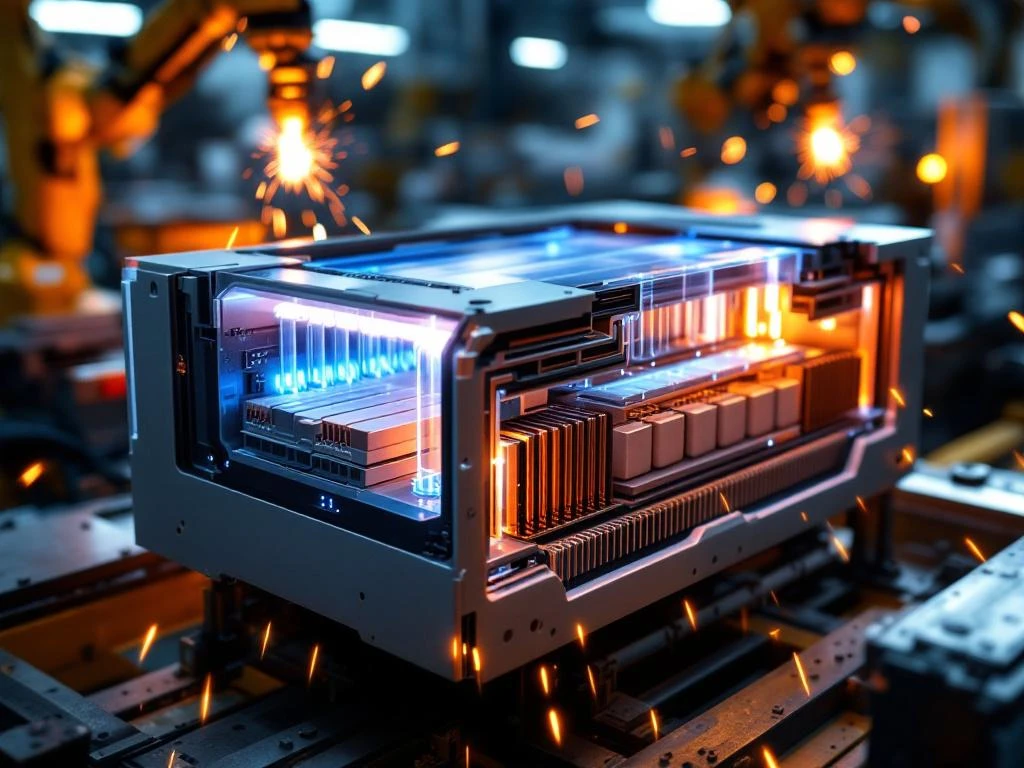When milliseconds matter and performance is everything, the last thing you want is a battery failure that could cost you a race or, worse, endanger your team. In high-performance racing applications, where Formula racing teams and sports car retrofits push systems to their absolute limits, battery enclosures serve as the critical barrier between safe operation and catastrophic failure.
Racing environments present unique challenges that standard consumer battery systems simply weren’t designed to handle. Extreme temperatures, intense vibrations, potential impacts, and the need for split-second emergency responses all demand specialised safety features in your energy storage safety systems. Understanding these eight critical safety features isn’t just about compliance—it’s about ensuring your team can focus on winning rather than worrying about battery-related incidents that could sideline your entire operation.
1. Thermal management and heat dissipation systems
Racing applications generate enormous amounts of heat, and your battery pack is no exception. Without proper thermal management, even the most advanced lithium-ion cells can experience thermal runaway—a dangerous chain reaction that can destroy your entire energy storage system and potentially cause fires.
Modern battery housing incorporates sophisticated cooling channels, heat sinks, and thermal barriers that work together to maintain optimal operating temperatures. These systems often include both passive cooling elements, such as aluminium heat spreaders and thermal interface materials, and active cooling solutions like liquid cooling loops or forced air circulation. Temperature monitoring sensors throughout the enclosure provide real-time data to ensure your system never exceeds safe operating parameters.
The key to effective thermal management lies in understanding your specific application’s heat generation patterns. Racing teams often see temperature spikes during acceleration phases, whilst sports car retrofits may experience sustained high temperatures during extended track sessions. Your thermal management system must be designed to handle these unique thermal profiles whilst maintaining consistent performance.
2. Fire suppression and flame retardant materials
Fire safety represents one of the most critical aspects of battery pack protection in racing environments. The combination of high-energy density cells, extreme operating conditions, and the presence of flammable materials in racing vehicles makes comprehensive fire protection absolutely essential.
Advanced battery enclosures utilise multiple layers of fire protection, starting with flame retardant housing materials that meet stringent automotive safety standards. These materials are specifically formulated to resist ignition and prevent flame propagation, buying precious time in emergency situations. Many systems also incorporate internal fire barriers that compartmentalise individual cell groups, preventing a single cell failure from affecting the entire pack.
Some high-end racing applications include integrated fire suppression systems that can automatically deploy extinguishing agents when thermal sensors detect dangerous temperature rises. These systems work in conjunction with the vehicle’s overall fire suppression setup, providing comprehensive protection that extends beyond just the battery enclosure itself.
3. Electrical isolation and insulation protection
High-voltage battery systems in racing applications can pose serious electrical hazards if not properly isolated. Electrical safety features must account for the unique challenges of racing environments, including exposure to moisture, vibration-induced wire movement, and the potential for impact damage.
Proper electrical isolation begins with high-quality dielectric materials that maintain their insulating properties even under extreme conditions. These materials must withstand not only high voltages but also temperature fluctuations, mechanical stress, and potential exposure to various fluids commonly found in racing environments. Ground fault protection systems continuously monitor for any breakdown in insulation integrity, immediately alerting operators to potential hazards.
Modern racing battery enclosures often incorporate multiple isolation barriers, creating redundant safety systems that ensure protection even if one barrier fails. This approach is particularly important in applications where maintenance windows are limited and system reliability is paramount.
4. Pressure relief and venting mechanisms
Battery cells can generate gases during normal operation and especially during fault conditions. Without proper pressure management, these gases can build up to dangerous levels, potentially causing enclosure rupture or creating explosive atmospheres.
Effective pressure relief systems include strategically placed venting mechanisms that allow safe gas evacuation whilst preventing the ingress of contaminants. These systems must be carefully designed to handle both normal outgassing and emergency situations where rapid pressure increases might occur. Explosion-proof designs ensure that even in worst-case scenarios, any pressure release occurs in a controlled manner that doesn’t endanger nearby personnel or equipment.
Racing applications often require specialised venting solutions that account for the vehicle’s aerodynamics and the potential for various orientations during operation. The venting system must function effectively whether the vehicle is upright, inverted, or at extreme angles commonly encountered in motorsport applications.
5. What environmental sealing protects against?
Racing environments expose battery systems to harsh conditions that would quickly destroy inadequately protected equipment. Dust from track surfaces, moisture from weather or cleaning operations, and corrosive substances from various automotive fluids all pose significant threats to battery safety features.
IP (Ingress Protection) ratings provide standardised measures of environmental protection, with racing applications typically requiring IP65 or higher ratings. This level of protection ensures complete dust ingress prevention and protection against water jets from any direction—essential when considering the high-pressure washing commonly used in racing vehicle maintenance.
Beyond basic moisture and dust protection, racing battery enclosures must resist corrosion from salt spray (in coastal racing venues), various automotive chemicals, and the acidic compounds that can form from combustion byproducts. Specialised gaskets, seals, and coating systems work together to create a comprehensive barrier against environmental threats whilst maintaining the enclosure’s other safety functions.
6. Impact resistance and structural integrity features
Racing incidents are an unfortunate reality, and battery enclosures must be designed to protect their contents even during significant impacts. The structural integrity of your custom battery systems can mean the difference between a repairable incident and a catastrophic failure.
Modern racing battery enclosures incorporate shock absorption systems, reinforced housing materials, and strategic crumple zones that protect the battery cells whilst maintaining structural integrity. These designs must balance weight considerations—crucial in racing applications—with the need for robust protection. Advanced materials like carbon fibre composites and high-strength aluminium alloys provide excellent strength-to-weight ratios whilst offering superior impact resistance.
Vibration dampening systems protect against the constant mechanical stress of racing operations. High-frequency vibrations from engines and road surfaces can cause fatigue failures in battery connections and structural components over time. Proper vibration isolation ensures long-term reliability even under the most demanding racing conditions.
7. Emergency shutdown and disconnect systems
When emergencies occur in racing environments, every second counts. Emergency shutdown systems must provide immediate, reliable disconnection of battery power whilst ensuring the safety of both the system and nearby personnel.
Modern emergency disconnect systems include multiple activation methods: manual switches accessible to drivers and crew members, automatic triggers based on impact sensors or other safety systems, and remote activation capabilities that allow race control or pit crews to shut down systems from a distance. These systems must function reliably even after significant damage to other vehicle systems.
Fail-safe designs ensure that emergency systems default to the safe state—power disconnected—rather than remaining energised if control systems fail. This approach is particularly important in racing applications where traditional troubleshooting methods may not be available during emergency situations.
8. Monitoring and diagnostic safety systems
Prevention is always preferable to emergency response, and advanced monitoring systems provide the early warning capabilities that racing teams need to maintain peak performance whilst avoiding dangerous situations. Industrial battery safety monitoring goes far beyond simple voltage and current measurements.
Comprehensive monitoring systems track dozens of parameters including individual cell voltages, temperatures throughout the pack, insulation resistance, vibration levels, and gas concentrations within the enclosure. Advanced algorithms analyse these data streams in real-time, identifying patterns that might indicate developing problems long before they become critical safety issues.
Predictive maintenance features help racing teams schedule maintenance activities during planned downtime rather than dealing with unexpected failures during critical racing periods. These systems learn the normal operating patterns of each specific battery installation, making them increasingly effective at identifying subtle changes that might indicate emerging issues.
Choosing the right safety features for your application
The eight safety features we’ve explored represent the foundation of reliable, safe battery operation in high-performance racing applications. However, the specific implementation of these features must be tailored to your unique requirements, whether you’re developing a Formula racing car’s energy recovery system or retrofitting a classic sports car with modern electric power.
Consider factors such as your typical operating environment, the level of performance you’re targeting, maintenance capabilities, and regulatory requirements when selecting safety features. Modular energy storage systems offer the flexibility to customise safety features for specific applications whilst maintaining proven, tested designs for critical safety functions.
The investment in comprehensive safety features pays dividends not only in risk reduction but also in system reliability and performance consistency. When your battery enclosure is properly designed and protected, your team can focus on what matters most—achieving peak performance on the track. If you’re ready to discuss how these safety features can be integrated into your specific racing application, we’d encourage you to contact our team to explore the possibilities for your next project.


